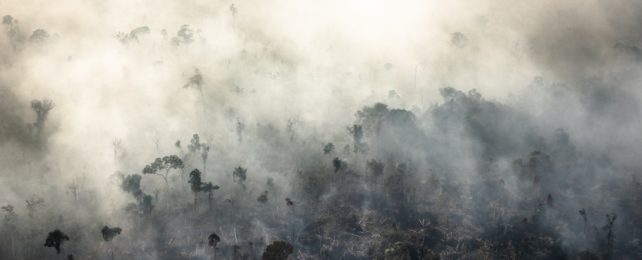Deforestation in the Amazon is nearing the point of no return, and if this ecosystem falls, it could flip from a vast carbon sink to a gushing carbon tap. Already, some climate scientists suspect the rainforest is spewing more carbon than it's absorbing.
If the Amazon crosses a critical threshold of self-resilience, a new study suggests the disaster could set off a domino effect, knocking over tipping points elsewhere in the world, too, abruptly accelerating environmental crises and causing irreparable damage to the planet.
Tipping points in the global climate system, such as collapsing ice sheets, glacier melt, forest dieback, sea level rise, and shifting monsoons, have received a lot more attention in recent years.
Each one of these switches could seriously turn up the heat on our planet, creating a 'hothouse Earth' with irreversible and catastrophic effects.
They are all connected by the global greenhouse effect, but in a climate crisis, it's uncertain in what order they will ultimately fall.
The most recent study focuses on the Amazon rainforest tipping point and some of its connections to other regional climate systems.
Using historical data from 1979 to 2019, an international team of climate researchers have drawn a link between tree loss in the Amazon and warmer temperatures in Tibet and the West Antarctic ice sheet.
Plugging this data into a model of the global climate system suggested the connection was closely synchronized with modern climate changes.
Periods of higher rainfall in the Amazon correlated with less precipitation in Tibet and West Antarctica.
Since 2008, snow cover on the Tibetan Plateau has been melting at a rapid rate similar to the Arctic.
The Plateau is sometimes known as Earth's third pole, and it plays important roles in global water storage and climate.
If the current study is correct, Tibet's loss of snow cover could be due, in part, to deforestation half a world away. The authors say the region is now operating close to a tipping point that tends to be overlooked.
"Our framework highlights that tipping elements can be linked and also the potential predictability of cascading tipping dynamics," the authors write.
The connection between Antarctica, Tibet, and the Amazon extends nearly 10,000 kilometers (6,200 miles), and it appears to be based on strong ocean currents and westerly winds.
In a review of the paper for Nature, climate scientist Valerie Livina from the United Kingdom's National Physical Laboratory agrees that the models show "strong correlations across long distances".
"This is the first time that the theory of complex networks has been applied in the context of tipping points, and the synergy of the two research areas provides an important insight into the global climate dynamics," Livina writes.
"This work opens a new area of tipping point analysis at a global scale."
Nevertheless, there is still a lot of complexity that needs to be incorporated into future models.
Deforestation in the Amazon impacts more than just Tibet and Antarctica. Previous studies suggest the climate of the Amazon, which is closely tuned by its trees, can have impacts on coral reefs in the Caribbean and reduce snowfall in the Sierra Nevada and the Cascade Mountains of North America, potentially triggering extreme drought on the west coast.
The planet's climate systems are intimately connected. It's a small world, after all.
The study was published in Nature Climate Change.
